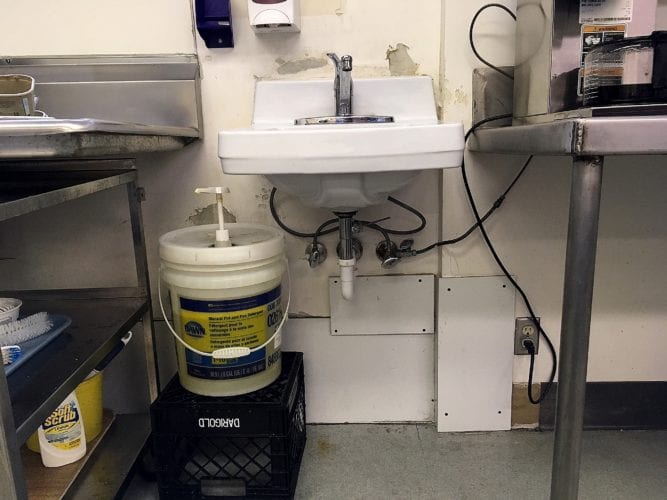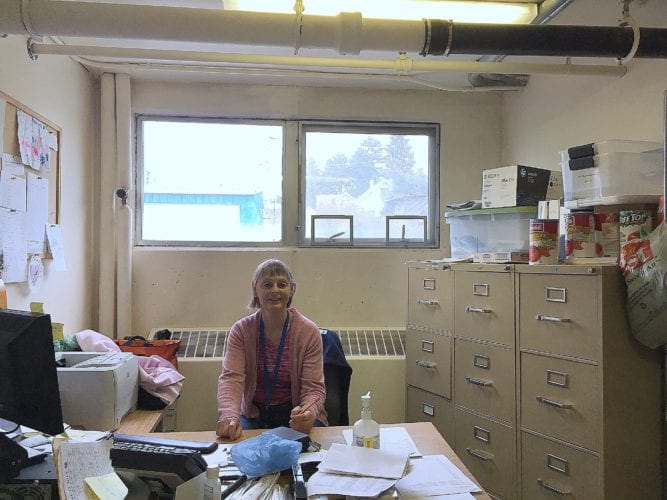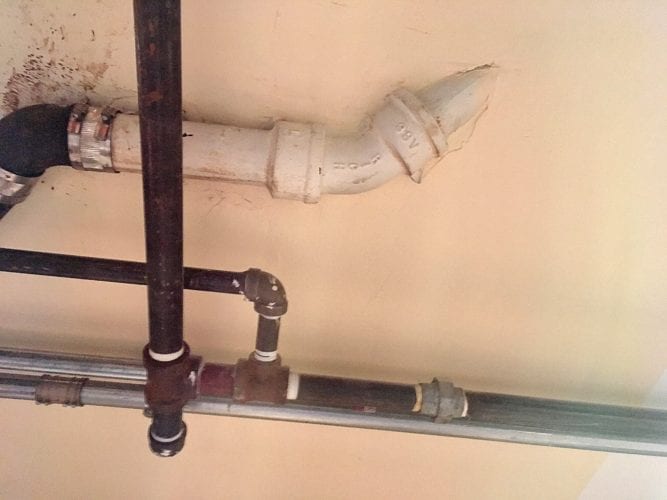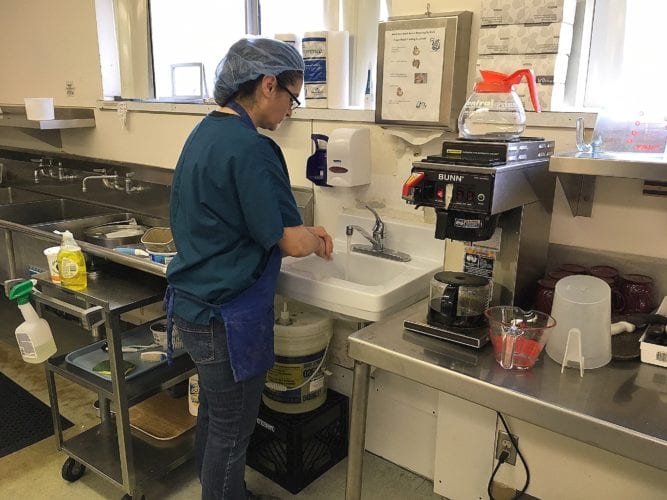About one hundred people work at the Petersburg Medical Center. It’s one of the largest employers in town. Its clinic is a busy place, seeing between 900 and a thousand visits per month. That area of the building is relatively new, remodeled about five years ago. Most patients probably don’t realize that other parts of the building are nearly 50 years old and failing.
But some of the workers do know like Jeanne Norheim. She works in the kitchen downstairs.
“We’ll come in sometimes in the morning and there’ll be water all the way over [the floor] to here,” Norheim said. “All the way over almost to the walk in refrigerator that we’ll have to mop and I’ve been here 17 years and we’ve had these leaks intermittently that entire time.”
Trying to fix the flooding problem for all of those years is Mike Boggs, the Maintenance Director for the hospital. You can see his work where he’s patched the walls in different places. But he says it’s like putting band aids on a gaping wound.
“We’ve changed plumbing or replaced plumbing to the point where it’s going down into the slab,” Boggs said. “And this building there’s no way to get under it. It’s right on fill.”

Patches covering plumbing repairs are visible under the hospital’s kitchen sink. Photo/Angela Denning
The problem is not the brick walls that you see, it’s the old wood studs and deteriorating plumbing behind the walls. So to do more they’d have to take out walls and cut through concrete.
“Which you can’t do while they’re making waffles,” Boggs said.
But the kitchen is not the only problem area.
Right down the hall from the kitchen is Norheim’s small office that she shares with two others. A sign on the door reads “Food and Nutrition Services Office”. The room also serves as storage overflow. Shelves of canned goods and extra kitchen serving trays line one wall.
Above Norheim’s desk, hanging about six inches below the ceiling, is a large pipe.
“When I first started working here I asked what kind of pipe that was and when I heard it was a sewer pipe I was a bit nervous,” Norheim said.
She had a right to be nervous too… because one day the pipe broke. Luckily, no one was in the office at the time.
“We call it ‘the fire’,” Norheim said, joking, “it sounds better.”
Norheim says they lost a lot of stuff like books in the office, which had to be thrown out from damage.

Dietitian, Margaret Fleming, shares an office with Norheim where the sewer pipe hangs above their heads. Photo/Angela Denning
Boggs also remembers that day well. He and other staff were dealing with the clogged sewer pipes in the building.
“We were upstairs working and it was like, ‘Oh, she’s free!’,” Boggs said. “And then we came down here and opened this door and it’s like, ‘Oh, my God!’ It’d choke a dog, yeah.”
The sewer pipe is like other parts of the building’s infrastructure that has been plaguing Boggs over the years. He didn’t know the sewer pipe was at risk.
“That’s cast iron pipe, that’s code,” Boggs said. “But there’s no way to tell how thin it is until it breaks and then you find out just the bottom of it is like a 32nd of an inch, it’s like the tin foil on gum.”
In the hallway, the industrial buzz of fluorescent lighting fills the air. We are near the guts of the building—where the electrical and plumbing systems live.
In another room nearby Boggs points to a pipe that runs below the ceiling and then turns upward.
“See how the plumbing just disappears into the ceiling?” Boggs asks. “And this is all the power. And that is dried now but that is where water has run right over our electrical panels from upstairs because you can’t push a pad back and you know…it’s been a real adventure.”

Old plumbing pipe at the hospital is difficult to replace when it disappears into the ceiling like this. Photo/Angela Denning
Or maybe a plumbing nightmare, I say.
“Yeah,” he agrees.
The hospital is far from the oldest building in town but Boggs argues that it’s the busiest with multiple groups of people using it.
“It’s the one place in town that it never sleeps,” Boggs said. “I mean there’s people here round the clock. Water’s being run, sewers are run, elevators are working. This place gets a workout 24-7.”
Despite the plumbing problems the hospital has passed all of its recent inspections. Things are up to code although some has been grandfathered in. The kitchen doesn’t have a separate produce sink, for example. But details like that would be remedied in a remodel that’s being proposed, estimated at about $300,000. That could pay for construction and design but doesn’t include new equipment or removing any possible hazardous material.
CEO Liz Woodyard says the money will come from either hospital investments or cash they have on hand. She says the operations side of the medical center is running smoothly and revenue looks stable. But the aging building is a problem.
“The oldest part is very concerning to us because it holds a kitchen and on the second floor is where long term care is and that’s really important to us to have a nice environment for the residents,” Woodyard said. “It’s their home and so we want to have a good environment for them.”
The long term goal is to get a whole new medical center. The current building is located near downtown with no room to expand. It’s just a few blocks up the hill from the water. The last time there was a tsunami warning all the patients had to be evacuated, including from the nursing home unit.
In the meantime, Woodyard says, staff remains dedicated to providing quality care even in a challenging environment.
The kitchen renovation project will be proposed to the hospital’s board of directors at their meeting Wednesday.










